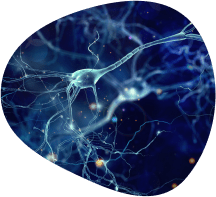Parkinson’s Disease
Parkinson’s disease is a neurodegenerative disorder that affects predominately the dopamine-producing (“dopaminergic”) neurons in a specific area of the brain called substantia nigra. Symptoms, which usually begin gradually and increase over time, can include difficulty walking and talking, mental and behavioral changes, sleep problems, memory difficulties, and fatigue.
Parkinson’s disease is the second-most prevalent neurodegenerative disorder worldwide. In the United States, approximately one million individuals are currently living with the condition, and that number is expected to increase to 1.2 million by 2030. Our dedication lies in the pursuit of treatments aimed at alleviating the suffering of those afflicted by Parkinson’s disease.
Pathology & Physiology
Parkinson’s disease and Alzheimer’s disease share many similarities with regard to the hypothesized central roles of inflammation and insulin resistance on disease processes, although the diseases typically begin their attacks on different parts of the brain. And like Alzheimer’s disease, PD may progress slowly, with worsening symptoms resulting in disability five to ten years after diagnosis.
The inadequate production and utilization of dopamine is directly related to the symptoms of PD. Inflammation is thought to be central to the processes that lead to the low dopamine state. It is known that the protein alpha-Synuclein (α-Syn) is over expressed and misfolded in PD. The defective form of α-Syn creates inflammatory SNA aggregates in substantia nigra. When healthy, the substantia nigra makes the movement mediating neurotransmitter, dopamine. Inflammation causes neuronal death and dysfunction in the substantia nigra and in surrounding regions of the striatum (a region of brain coordinating motion, decision making, and other important functions), leading to a shortage of dopamine and suboptimal brain activity related to the lower concentration of dopamine present because of neuron death.
Clinical studies have shown that patients must have two underlying conditions at the same time to develop Parkinson’s symptoms: 1) low dopamine levels in the brain; AND 2) inflammation and the associated insulin resistance. A clinical trial has shown that reducing insulin resistance in the brain restores motor control for Parkinson’s patients, but there has never been a practical treatment approach to accomplish this.
As such, most PD patients are treated with levodopa in combination with carbidopa. The combination slows L-dopa metabolism to a form that can not be transported into the brain (dopamine). Prolonged use of L-dopa, however, has been associated with the frequent development of involuntary movements called L-dopa induced dyskinesia (LID). The abnormal involuntary movements of LID can be as disabling as PD itself and may be regarded as a major limitation toL-dopa therapy.
In scientific studies, (BioVie, data on file) bezisterim (NE3107) has shown the potential to decrease neuroinflammation and the resulting insulin resistance to slow neurodegeneration and improve neuron function.
LEARN MORE ABOUT OUR NOVEL CANDIDATE FOR PARKINSON’S

Alzheimer’s
It’s about giving people hope, empowering them to take control of their health, and inspiring them to live their best lives.


